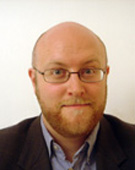Dr. Fredrik Linaker
The NewScientist article Video search makes phone a “second pair of eyes” said
“Video-equipped cellphones could soon offer simple way to find useful information about the surrounding world.Currently, the best way to use a cellphone to find information about, for example, a product or an ad on a wall is by entering an internet search query with the keypad. Soon, however, it may be easier to simply record a video clip of an item of interest and have your phone tell you about it instead.
Researchers at Accenture Technology Labs in France have developed technology that makes this possible using any ordinary 3G cellphone equipped with a video camera.
The prototype system, dubbed the Pocket Supercomputer, offers a simple way to seek out useful, hard-to-find information, says Fredrik Linaker who led the system’s development at Accenture.”
Fredrik Linaker, Ph.D. is Researcher, Accenture Technology Labs. His research interests are: Real-time sensing, processing and actuation, Vision and image based recognition, and Mobile computing and robotics. He studies sensing, actuation, real-time systems, computer vision, robotics, artificial intelligence, Bayesian networks, and sensor fusion.
His recent projects include:
Pocket Supercomputer (project leader): Leverages new high-speed low-latency telecommunications and networking infrastructure along with state-of-the art image and sound processing algorithms to create an experience of an always available, immensely powerful and intelligent ‘contextually aware’ device that fits in the user’s palm or pocket. Current working prototype includes full-framerate visual object recognition, audio/video media streaming and recording, motion-controlled camera steering and 3D viewport control, transparent augmented reality overlays, speech generation, and more, all on a standard camera phone or wifi portable device.
3D Object Map Building (project leader): Using visual simultaneous localization and mapping technologies for handheld cameras (monocular SLAM), a full 3D map of the sensed environment is built and updated in real-time and virtual objects and instructions overlaid on a display depending on the device position and orientation. This allows training and maintenance instructions to be adapted in real-time depending on context such as viewing-angle, object state, and current step in the procedure.
Mapping Robot (project leader): Visual object recognition and robot localization technologies enable an automated construction of metric maps denoting the positions of objects within an office or warehouse environment without having to tag any of the objects. The resulting maps can be used in post-disaster situations, for insurance and safety compliance verification, as well as for guided object retrieval, inventory and stock-taking.
Tele-operation Table (project leader): Miniature replicas of vehicles are manually positioned and tracked on a table map surface and tele-operation commands are automatically sent to the vehicles to maneuver to these target positions. As the surface is a projected map, it is updated with global information and local sensor information from all the vehicles in real-time, giving a unified and natural control interface for homes, warehouses and larger geographical areas where multi-unit coordination and control is an issue.
Fredrik authored From Time-Steps To Events And Back and Unsupervised Online Data Reduction for Memorization and Learning in Mobile Robotics, and coauthored Time Series Segmentation Using an Adaptive Resource Allocating Vector Quantization Network Based on Change Detection, Mobile Robot Learning of Delayed Response Tasks through Event Extraction: A Solution to the Road Sign Problem and Beyond, Extraction and inversion of abstract sensory flow representations, and Sensory Flow Segmentation using a Resource Allocating Vector Quantizer. Read the full list of his publications!
Fredrik earned his B.Sc. and M.Sc. in Computer Science at the University of Skovde, Sweden, earned his Ph.D. in Computer Science at the University of Sheffield, UK, and did his Postdoc at Kyushu Institute of Technology, Japan.
